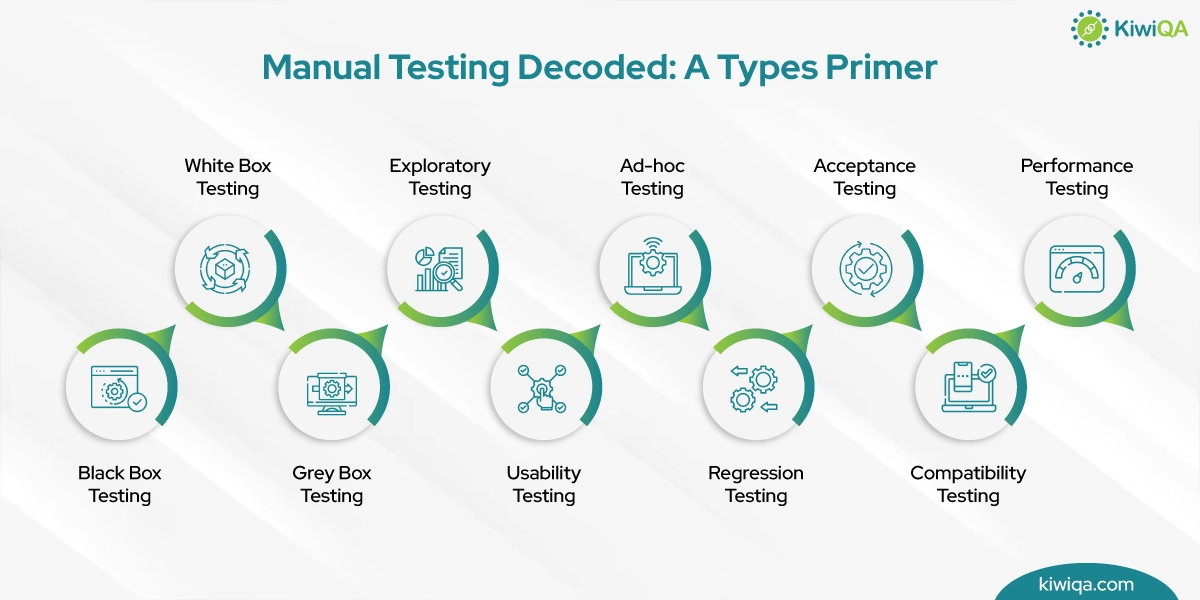Manual Testing is a software testing type that allows testers to evaluate application & software quality manually. In this Testing, you don’t require any automated testing tools & executed testing scripts. Manual Testing in the software development cycle plays an important role in evaluating software errors, bugs, and issues that can hamper the end-user experience. In manual Testing, the developer manually runs the application & implements features they have coded.
The simplicity of manual Testing is best for testing personal projects. Manual testers are expert QA professionals who enhance the software quality for the end users. The QA testing team helps your software meet the standard practices. This post will discuss manual testing services and how they benefit any software. Read this blog to understand how manual Testing is crucial in evaluating software quality.
Types of Manual Testing
1. Black Box Testing
This Testing aims for functionality testing & behavior of software without understanding the code and internal structure. The tester treats an application as a black box and determines how it handles multiple inputs and delivers significant outputs. It is used for evaluating the behavior & how the software performs from the end user’s point of view. To understand how it works, let’s take a simple example.
For example, if you want to test any social application through black box testing, it would take the user name & password, and the expected output is to get logged into the application. Multiple black box testing techniques validate the system against the predefined requirements. Black box testing techniques contain all levels of Testing along with functional & non-functional Testing.
-
Functional Testing
In functional Testing, the quality engineer confirms whether the application features work based on specific requirements. This Testing can be done manually or through automated tools based on the specific test case.
-
Non-Functional Testing
Non-functional Testing evaluates the software application’s performance, dependability, usability, and other non-functional characteristics.
-
Regression Testing
This software testing is conducted after the code update to ensure that the updated code has included no bugs. The new code may bring new logic that later conflicts with the existing code and causes errors. This is why the QA team conducts a series of regression test cases that they will re-execute every time the code changes to save time and foster testing efficiency.
Also Read: Top 10 Best API Security Testing Tools To Use in 2024
2. White Box Testing
White box testing, or glass box testing, is utilized to test the software infrastructure & internal coding. The Testing aims to check the predefined- input against the desired output. To access this type of Testing, the QA testers require an understanding of programming knowledge that focuses on coding structure.
The main goal of this testing is to focus on the output and input through the software and foster the securing of software. Every line of the code is tested. After processing the white box techniques, the developer sends the software to the testing team for performing black box testing & validating the software with specific requirements. Here are the examples of White Box Testing Techniques-
-
Code Coverage
Code coverage is the Testing that helps to understand how much the sources are tested. It’s a useful metric that helps to assess the test suite quality.
-
Path Testing
Path testing is the white box approach based on the program’s control structure. The Testing is dependent on the controlling structure of the program.
-
Loop Testing
This is one of the basic concepts which are integrated into a large number of algorithms. This Testing aims to reveal the vulnerabilities that might exist in a particular loop.
3. Grey Box Testing
It is a combination of both black and white box Testing approaches. A black-box testing approach involves testing the system’s functions while remaining oblivious of the system’s fundamental structure. White box testing involves evaluating the internal code framework of a system.
Grey box testing is mostly used for integration and penetration testing. Integration testing involves evaluating individual system elements as a group. Penetration testing involves simulating numerous scenarios that might result in malicious hacking efforts and identifying system weaknesses against such attacks. The testing methods that can be integrated with grey box testing are matrix testing, pattern testing, regression testing, and orthogonal array testing.
4. Exploratory Testing
Exploratory Testing is a sort of unplanned, manual software testing in which testers study the system without pre-established test cases or prior experience with it. Instead of adhering to a precise test strategy, they dive right in and make spontaneous judgments on what to test on the spot. Exploratory Testing is a famous Agile methodology that aims at exploration, discovery, and learning.
It highlights the tester’s independence and responsibility. Testing is useful when the required documents are not or are partially available. The Testing contains investigation that helps to find more bugs than the normal Testing. Through this, the QA team uncovers the bugs and errors that are ignored by other testing techniques. The Testing covers multiple testing types, and it covers multiple scenarios & cases. It also generates new ideas during the test execution.
5. Usability Testing
Usability testing is utilized to assess the usability of software by asking users to do specific tasks and observing them do so. Usability tests investigate user behavior, especially whether users can utilize a service or software efficiently, effectively, and successfully.
However, UX specialists use usability testing to assess experience beyond the more practical meaning of usability. Usability testing is a technique for gathering feedback and data about user experiences that involves watching testers engage with the product. Usability testing allows you to run usability tests at any stage of the planning or development process.
You may evaluate usability in the early stages, on design prototypes, and later in the development procedure, on websites or applications. It is recommended to run the usability testing during the development phase. Organizations should focus on usability testing to save significant time, improve savings, and minimize costs. It ensures the organization that the software they will release in the market offers success.
6. Ad-hoc Testing
Ad hoc testing is the form of tests performed on applications since it involves little preparation or planning. Ad hoc Testing aims to identify defects and issues at various phases of software development. Because it does not adhere to any test strategy, it doesn’t require documentation or specialized methodologies for developing test cases.
Ad hoc testing, which can be performed at any time throughout the application’s development, has no set framework. However, it isn’t as hectic as it sounds. It needs testers to have a thorough grasp of the programming knowledge. One of the advantages of ad hoc testing is it requires less time than formal testing procedures.
You’ll save a lot of time since you’re not following a fixed approach or documenting every step. Ad hoc testing is an excellent technique to identify flaws in your program at an early stage, ensuring that your product is only delivered to the end user when it is in flawless condition. The types of Ad hoc testing are buddy testing, monkey testing, and pair testing.
Also Read: Testing Mobile Apps in the Cloud: Benefits and Strategies
7. Regression Testing
This is a technique of software testing that repeatedly runs the functional and non-functional tests & ensures that the software apps work in top-notch conditions after changing codes, software updates, improvements, & optimization. Regression testing is a necessary section of the software development cycle since it enables developers to track unexpected errors in the app that may begin due to enhancements & extensions of the codebase.
The testing offers overall stability of the software/application by tracking the features of existing functions. It is a necessary step that every organization must utilize after modifying the codes in the software. The Testing ensures that the system can withstand even after frequent improvements.
8. Acceptance Testing
This Testing is performed for software testing for acceptability. This Testing aims to evaluate system compliance with specific requirements and whether the system is acceptable for release. The Testing is performed after the development of the software & before releasing the software available in production. Acceptance testing is classified into two types where one is internal acceptance testing & another is external acceptance testing. Here are some more types of Acceptance Testing you should know about-
-
User Acceptance Testing (UAT)
This Testing is performed by the end-users & the client representatives to prove whether the system meets the business requirement. It typically includes the real-world scenario & ensures the software is ready for deployment.
-
Business Acceptance Testing (BAT)
The following Testing aims to determine if a business system and the software meet the expectations and requirements of users. In other words, BAT involves the evaluation of a software product to check whether it is good enough to be used by real-world users.
9. Compatibility Testing
Compatibility testing determines if a program or product is compatible with various computer environments. It is a component of nonfunctional Testing. It evaluates the application and product’s usability, dependability, and performance. Browser and software compatibility testing is vital since it allows organizations to produce applications that function properly on practically any device. For example, cross-browser compatibility testing ensures that Opera users get the same experience as those who use Firefox and other major browsers.
Compatibility testing allows you to discover any potential difficulties that may develop while using the operating system or application in the specified environment. This allows you to address such problems before the system and application launch, saving time and resources. Compatibility testing ensures that your application or system will function on various software and hardware platforms, which may help you expand your market share and appeal to a larger audience.
10. Performance Testing
Performance testing is a type of software testing that is used to test the software’s efficiency, flexibility, and security. To do this, testers frequently use various performance testing methods and tools based on the type of product being tested. Performance testing assesses a system’s capacity to manage large amounts of requests and data and peak loads. It aids in identifying any technical problems or performance concerns in the system.
The primary purpose of performance testing is to guarantee that the system satisfies the performance needs of the end users. It aids in identifying any flaws that may cause a system to crash under specific circumstances. Furthermore, performance testing aids in identifying the system’s capacity and ability to manage various degrees of workloads. It is an important phase in software development since it ensures stability and efficiency.
The performance testing guides are necessary for ensuring a smooth user experience, validating the system’s reliability, preventing revenue loss, fostering SEO ranking, and avoiding future performance issues. Performance testing is necessary to guarantee that programs run smoothly and deliver an ideal user experience. It can also assist in avoiding costly difficulties in the future by identifying possible concerns before the development phase.
Maximize Quality: Get Advanced Manual Testing Solutions Today!
In this evolving technological landscape, software quality plays a strong role in the success of digital products. There are many key players in the software development industry, and manual QA testers are one of them! The QA testing team plays a crucial role in software development quality.
To achieve the best standard of quality software, it is necessary to collaborate with trusted & professional manual software testing services. For the success of any software development project, the manual testers’ QA team plays a strong role. The QA testing team you choose must have experience in the planning & execution of the tests. If you want to release quality software in the market, follow the above blog and run the necessary testing type.








